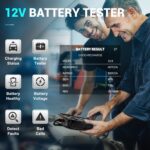Are you having trouble connecting My Obd2 Bluetooth scanner to your iPhone? You’re not alone. Many users encounter issues when trying to pair ELM327-based OBD2 scanners with iOS devices, while they often work seamlessly with Android. Let’s explore why this happens and what you need to know.
The ELM327 Bluetooth OBD-II scanner is a handy tool for car enthusiasts and DIY mechanics. Plug this small device into your car’s OBD2 port, and it can wirelessly transmit data from your vehicle’s computer to your smartphone, tablet, or laptop. This allows you to read diagnostic trouble codes, monitor engine performance, and access a wealth of information about your vehicle’s health using compatible apps.
Alt: Locating the OBD2 port in a car, typically under the dashboard on the driver’s side.
However, if you’re an iPhone or iPad user, you might have discovered that pairing your ELM327 Bluetooth scanner is not as straightforward as it should be. Unlike Android devices, iPhones and iPads often fail to detect or connect to these Bluetooth OBD2 scanners. When you search for Bluetooth devices in your iOS settings, the ELM327 scanner simply doesn’t appear in the list of available devices.
This discrepancy raises a common question: Why does my OBD2 scanner work with Android but not with my iOS device? The issue primarily lies in the type of Bluetooth protocol used by most ELM327 scanners. These scanners typically utilize classic Bluetooth, while Apple devices often prefer Bluetooth Low Energy (BLE) for pairing with accessories, especially for data transfer.
Alt: A smartphone displaying a Bluetooth connection icon, symbolizing wireless communication.
While both Android and iOS devices support classic Bluetooth, the way they handle pairing and communication with these devices can differ. In many cases, the standard Bluetooth pairing process on iOS is not compatible with the specific Bluetooth implementation in many ELM327 scanners. This isn’t necessarily a fault of the scanner itself, but rather a compatibility issue between the scanner’s Bluetooth protocol and iOS’s Bluetooth management.
The On-Board Diagnostics II (OBD-II) protocol itself is universally used by most car manufacturers, providing a standardized way to access vehicle diagnostic information. This protocol has evolved since the 1980s, becoming increasingly sophisticated in the data it can provide. You can learn more about OBD-II protocol at http://en.wikipedia.org/wiki/On-board_diagnostics. For more details on ELM327 Bluetooth devices, resources like http://www.amazon.com/Soliport-Bluetooth-OBDII-Diagnostic-Scanner/dp/B004KL0I9I/ ref=pd_sxp_grid_pt_0_2 offer further information.
So, while my OBD2 scanner may not natively pair with your iPhone via standard Bluetooth settings, there are often workarounds or alternative solutions. Some newer OBD2 scanners are designed with dual-mode Bluetooth, supporting both classic Bluetooth and BLE, which can improve compatibility with iOS devices. Additionally, some apps designed for OBD2 diagnostics on iOS might have specific pairing procedures or recommend particular types of scanners that are known to work well with iPhones and iPads.
In conclusion, the challenge of connecting my OBD2 Bluetooth scanner to an iPhone often stems from Bluetooth protocol differences and iOS device handling of classic Bluetooth pairing. While frustrating, understanding this limitation can guide you towards finding compatible scanners or apps that bridge this gap, allowing you to effectively use OBD2 diagnostics with your iOS device.
